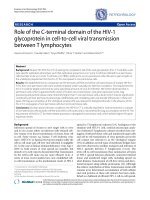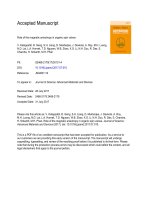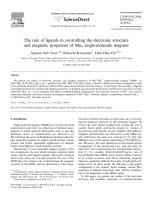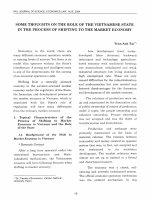The role of stethoscopes in the transmission of hospital infections
Bạn đang xem bản rút gọn của tài liệu. Xem và tải ngay bản đầy đủ của tài liệu tại đây (163.96 KB, 7 trang )
Int.J.Curr.Microbiol.App.Sci (2019) 8(1): 2472-2478
International Journal of Current Microbiology and Applied Sciences
ISSN: 2319-7706 Volume 8 Number 01 (2019)
Journal homepage:
Original Research Article
/>
The Role of Stethoscopes in the Transmission of Hospital Infections
Pratiksha Srivastava1, Atosh Tripathi1*, Priti Agrawal2, Dilshad Arif1,
Satendra Pratap Singh1 and Anil Kumar1
1
Department of Microbiology, Government Medical College & Super Facility Hospital,
Azamgarh, U.P., India
2
Department of Microbiology, SGT Medical College, Gurugram, Haryana, India
*Corresponding author
ABSTRACT
Keywords
Stethoscopes,
Transmission,
Hospital infections,
S. aureus
Article Info
Accepted:
17 December 2018
Available Online:
10 January 2019
Among medical care equipments Stethoscope is one of the most frequently used device.
Stethoscopes are mainly used by the health professionals for the assessment of the patients
and have been reported to be one of the common vectors for the nosocomial infection in
various parts of the world. The contamination of Stethoscope particularly the diaphragm is
mainly reported due to the lack of regular disinfection. The objective of this study was
Isolation and identification of the microorganisms responsible for nosocomial infection
from the stethoscopes used by health care professionals and to know the antibiotic
resistance pattern of the isolated microorganisms. The prospective study was conducted in
the Department of Microbiology, Government Medical College, Azamgarh. Samples were
collected from the 100 stethoscopes of the clinicians and other health care personnel
working in the Government Medical College, Azamgarh. Swab samples were taken from
the surface of the diaphragm of each 100 stethoscopes. Swabs were cultured onto
appropriate culture media, biochemical tests were performed for identification and
antibiotic susceptibility test was done to know the pattern of resistance and multi drug
resistant isolates. Out of 100, 88 stethoscopes were found to be contaminated with
different microorganisms. CONS was the most frequently isolated organism followed by S.
aureus, Micrococci, Bacillus spp, Candida spp, Pseudomonas spp, Aspergillus spp and
Enterobacter spp. Gram positive isolates showed resistance towards Gentamicin,
Clindamycin and Erythromycin. It is necessary to disinfect the stethoscope after each use.
This is the only way to prevent dissemination.
Introduction
Nosocomial infection is a significant problem
worldwide. Infection transmission remains a
significant hazard for hospitalized patients.(1)
Transmission of infections can result due to
multiple causes like development and
persistence of multidrug resistant bacteria;
prolong
hospital
stay
and
immunocompromised state of patients and
mechanical transmission of agents from one
patient to another.
2472
Int.J.Curr.Microbiol.App.Sci (2019) 8(1): 2472-2478
Unwashed hands and contaminated medical
devices can act as the source of nosocomial
infections.(2) Medical devices such as
electronic thermometer, blood pressure cuffs,
stethoscopes, latex gloves, gowns, masks,
neckties, pens, badges, white coats,
respiratory devices can act as a potential
source of nosocomial infection. (1, 3)Medical
equipments used in the non-critical care
setting are less likely to have standard
disinfection and cleaning protocols than
equipments in the critical care settings. Thus
medical care equipments are more likely to
carry considerable number of pathogenic
microorganism. (4)Among medical care
equipments Stethoscope is one of the most
frequently used device. Stethoscopes are
mainly used by the health professionals for
the assessment of the patients and have been
reported to be one of the common vectors for
the nosocomial infection in various parts of
the world. (5) The contamination of
Stethoscope particularly the diaphragm is
mainly reported due to the lack of regular
disinfection (Before and after examining each
patient). Stethoscopes can be a potential
source of infection and can transfer
microorganisms from one person to another
person.
The objective of this study was Isolation and
identification
of
the
microorganisms
responsible for nosocomial infection from the
stethoscopes
used
by
health
care
professionals, to know the antibiotic
resistance
pattern
of
the
isolated
microorganism and to know the effectiveness
of 70% ethanol as cleaning agent for
stethoscopes.
Materials and Methods
The prospective study was conducted in the
Department of Microbiology, Government
Medical College, Azamgarh. Samples were
collected from the 100 stethoscopes of the
clinicians and other health care professionals
working in the Government Medical College,
Azamgarh. Swab samples were taken from
the surface of the diaphragm of each 100
stethoscopes. Sterile cotton swab dipped in
sterile saline was used for sample collection.
Swabs were immediately transferred to
Microbiology laboratory and inoculated onto
5% Sheep blood agar, Mac Conkey agar and
Sabouraud’s dextrose agar. The inoculated
plates were incubated aerobically at 370
Celsius for 48 hours. One of each
uninoculated plates were also incubated with
these as quality control.
Afterwards bacterial colonies were counted
and identification of the organism was done
by the colony morphology, gram staining and
biochemical reactions. Antibiotic sensitivity
test of the isolated microorganisms was
performed by Kirby Baeur disk diffusion
method. Antibiotics used were Vancomicin,
Erythromycin,
Gentamicin,
Cefoxitin,
Rifampicin and Clindamicin for gram positive
bacteria
and
Imipenem,
Meropenem,
Tetracyclin,
Teicoplanin,
Cefotaxime,
Ceftazidimeand Ciprofloxacin for gram
negative bacteria.
In addition randomly 25 stethoscopes were
cleaned with 70% ethanol, allowed to dry and
then sampled, to know the effect of 70%
ethanol as cleaning agent.
Results and Discussion
One hundred stethoscopes of health
professionals from different wards, OPD’s,
and ICU’s were included in this study. After
48 hours of incubation the bacterial load
varied from one stethoscope to other. Total 88
stethoscopes showed the culture positivity
represents the contamination of the diaphragm
of the stethoscope. 12 stethoscopes were
sterile. Out of 12 sterile stethoscopes 07
showed very less number of colonies (2-3), so
2473
Int.J.Curr.Microbiol.App.Sci (2019) 8(1): 2472-2478
considered as sterile or not significant (Table
1 and 2).
Antibiotic susceptibility pattern of the
isolates
The average number of colonies per
stethoscope was 30-35 and highest was 74.
Totally of 131 bacterial strains were isolated
from 88 contaminated stethoscopes. The
maximum isolation per diaphragm was 03
types of organism and minimum isolation was
single organism.
Among the 54 isolated CONS species and 31
S. aureus, most of the strains showed
sensitivity to the Rifampicin (100%),
Vancomycin (100% and 98%) and Cefoxitin
(83% and 79%) respectively and they showed
resistance towards Gentamycin, Clindamycin
and maximum resistance to the Erythromycin.
Majority of the isolated organism were found
to be potential pathogens. CONS were the
most frequent isolate (41.22%) among gram
positive isolates followed by S. aureus
(23.66%), Micrococci (10.68%) and Bacillus
spp (9.16%) (Fig. 1).
Among the 05 isolates of Pseudomonas spp
and 03 isolates of Acinetobacter spp
sensitivity was seen to the Imipenem,
Meropenem, Teicoplanin, Tetracycline and
resistance was seen to the Cefotaxime,
Ceftazidime and Ciprofloxacin.
From gram negative isolated organism
Pseudomonas spp (3.81%) was the most
common followed by Enterobacter spp
(2.29%).
Cleaning the randomly selected 25
stethoscopes with70% ethanol demonstrated
significant decrease in the bacterial count. Out
of 25 cleaned stethoscopes only 02
stethoscopes showed the bacterial growth
with very less number of colonies thus
demonstrating the effectiveness of cleaning
(Fig. 2 and 3).
Among fungal isolates Candida spp (6.10%)
was the most frequent followed by
Aspergillus spp (3.05%).
Table.1 Number of contaminated and sterile stethoscopes
Parameter
Total number of stethoscopes studied
Number of stethoscopes showing bacterial
and fungal growth
Number of stethoscopes showing no growth
/ not significant growth
Number of stethoscopes
100
88
12
Table.2 Number of isolates per stethoscope
S.No.
1.
2.
3.
Number of
Stethoscope
45
28
10
Number of isolated organism
per stethoscope
01
02
03
2474
Total number of organism
(131)
45
56
30
Int.J.Curr.Microbiol.App.Sci (2019) 8(1): 2472-2478
Fig.1 The pie diagram showing the distribution of the isolated microorganisms
Fig.2 Antibiotic resistance pattern of S. aureus and CONS
2475
Int.J.Curr.Microbiol.App.Sci (2019) 8(1): 2472-2478
Fig.3 Percentage of MRSA and MSSA
The result of this study revealed that 88 out of
100 studied stethoscopes showed growth of
different microorganisms and 12 stethoscopes
showed no growth. Many studies showed the
similar results as Gurjeet Singh et al., (2014)
reported the growth in 91 (89.22%)
stethoscopes out of 102 stethoscopes studied,
Chicozie et al., (2010) surveyed the 107
stethoscopes and they found 84 (79%)
contaminated stethoscopes, Youngster et al.,
(2008) also reported the rate of contamination
of stethoscope was 85.7% while Kilic et al.,
reported relatively low rate of contamination
of stethoscopes than present study, as well as
Marinella et al., Neetu Gupta et al., reported
100% stethoscope contamination which is
higher than our finding.
Gram positive bacteria (84%) were more
frequent than gram negative (07%) bacteria.
This might be because of the direct contact of
the stethoscope to human skin flora, which
contain mostly gram positive bacteria similar
to the study of Teklu Shiferaw et al.,
In this study maximum number of
stethoscopes were contaminated with CONS
(41%) which is same as finding of Marinella
et al., Neetu Gupta et al., and Foteini et al.,
while some studies as Gurjeetsingh et al.,
Chigozie et al., and Francis Marie et al.,
showed the maximum isolated bacteria was S.
aureus.
Different species of CONS and S. aureus
have the ability to acquire multi drug
resistance and these species can be extremely
virulent for population at risk. Therefore their
antimicrobial resistance pattern was studied.
Maximum number of isolated CONS and S.
aureus showed high rate of sensitivity to
Vancomycin, Rifampicin and Cefoxitin and
resistance
towards
Clindamycin,
Erythromycin and Gentamicin similar to the
study of Neetu Gupta et al., where CONS
showed sensitivity towards Cefoxitin and
resistance to Erythromycin. One more study
by TekluShiferaw et al., also explained that
isolated S. aureus and CONS were sensitive
to Cefoxitin and Vancomycin.
2476
Int.J.Curr.Microbiol.App.Sci (2019) 8(1): 2472-2478
On the other hand an average number of 4.5
% stethoscopes were colonized with MRSA
and19% with MSSA in this study.
Nevertheless, some studies reported rates as
high as 69 % for MRSA (Sengupta et al.,)
while some show very less number of MRSA
13% (Neetu Gupta et al.,).
Although most patients might not be
especially prone to infection after contact
with contaminated stethoscopes, those with
open wounds like patients with burns or
immunocompromised patients may be
colonized leading to infection at a later time.
The other risk likewise, would be the possible
dissemination of multiresistant organisms that
may be manifest in a later outbreak as has
been seen in hospital endemics traced to the
use of contaminated thermometers, blood
pressure cuffs or stethoscopes. In this study
the importance of cleaning the stethoscope
with 70% ethanol was also demonstrated.
Comparatively very fewer bacterial colonies
were obtained and in maximum stethoscope
which were cleaned by the 70% ethanol no
growth was observed, it is similar to the study
of Marinella et al., Neetu Gupta et al., and
Chicozie et al., that they also observed that
bacterial isolates from stethoscopes were
significantly reduced after they were cleaned
with different cleaning agent.
In conclusion stethoscopes can be a potential
source of infection as they transfer
microorganisms from one patient to another.
The major risk involves with the multidrug
resistant strains. Our finding also gives strong
evidence of the stethoscope mediated transfer
of microorganisms. It is necessary to disinfect
the stethoscope after each use. Hopefully our
results may convince clinicians/health care
personnel to understand the importance of
proper disinfection of stethoscopes. This is
the only way to control the dissemination of
infection. Our study also showed the
effectiveness of 70% ethanol as cleaning
agent. Furthermore studies should be done for
better
methods
of
disinfection
of
stethoscopes.
References
1.
2.
3.
4.
5.
6.
7.
2477
Leontsini
F,
Papapetropoulos
A,
Vantarakis A. Stethoscopes as vectors of
multi resistant coagulase negative
staphylococci in a tertiary hospital,
International journal of Medical science
and public health;2013;Vol 2; Issue 2;
2013.2.338-343.
Kilic IH, Ozaslan M, Karagoz ID, Zer Y,
Savas E, Davutoglu V. The role of
stethoscopes in the transmission of
hospital infections; African journal of
biotechnology; Vol. 10(30), pp. 57695772, 27 June, 2011
Gupta N, Gandham N, Misra RN, Jadhav
S, Ujgare M, Vyawahare C. The potential
role of stethoscopes as a source of
nosocomial infection; Medical journal of
Dr. D.Y. Patil University; Mar-April
2014; Vol 7; Issue 2; 156-159.
Shiferaw T, Beyene G, Kassa T and
Sewunet T; Bacterial contamination,
bacterial profile and antimicrobial
susceptibility pattern of isolates from
stethoscopes at Jimma University
Specialized Hospital; Annals of Clinical
Microbiology and Antimicrobials; 2013;
12; 12-39.
Raksha, Singh G, Urhekar A.D., Arif D,
Nissar J; Stethoscopes: A vector of
hospital
acquired
infections?
International Journal of Universal
Pharmacy and Bio Science; 3(2): MarApr 2014; 176-185.
Uneke CJ, Ogbonna A, Oyibo PG, Onu
CM:
Bacterial
contamination
of
stethoscopes used by health workers:
public health implications. J Infect
DevCtries 2010, 4(7):436–441.
Youngster I, Berkovitch M, Heyman E,
Lazarovitch Z, Goldman M. The
Int.J.Curr.Microbiol.App.Sci (2019) 8(1): 2472-2478
stethoscope as a vector of infectious
diseases in the paediatric division.
ActaPaediatr. 2008; 97(9): 1253-55.
8. Marinella MA, Pierson C, Chenoweth C.
The stethoscope. A potential source of
nosocomial infection? Arch Intern Med.
1997; 157(7): 786-790.
9. Francis Marie C. Africa-apurino, M.D.,
Emmanuel Edwin R. Dy, M.D. and
Remedios F. Coronel; Stethoscopes: A
potential source of nosocomial infections;
Infectious disease and Tropical Medicine.
10. Uneke CJ, Ogbonna A, Oyibo PG,
Ekuma U. Bacteriological assessment of
stethoscopes used by medical students in
Nigeria: implications for nosocomial
infection control. World Health Popul.
2008; 10: 53-61.
11. Sengupta S, Sirkar A, Shivananda P.
Stethoscopes and nosocomial infection.
Indian J Pediatr 2000; 67(3): 197-9.
12. D'mello D, Daley AJ, Rahman MS, QuY,
Garland S, Pearce C. Vancomycin
heteroresistance in bloodstream isolates
of Staphylococcus capitis. J Clin.
Microbiol. 2008; 46(9): 3124-6.
13. Cohen H, Amir J, Matalon A, Mayan R,
Beni S, Barzilai A: Stethoscopes and
otoscopes: a potential vector of infection?
Fam Pract 1997, 14: 446–449.
14. Kotsans D, Scott C, Gillespie EE,
Korman TM (2008) ‘What’s hanging
around your neck? Pathogenic bacteria on
identity badges and lanyards’ Med. J.
Aust., 188: 5–8.
15. Bukharie HA, Al-Zahrani H, Rubaish
AM, Abdulmohsen MF. Bacterial
contamination of stethoscopes. J Fam
Community Med., 2004; 11:31-3.
16. Alothman A, Bukhari A, Aljohani S,
Muhanaa A. Should we recommend
stethoscopes disinfection before daily
usage as an infection control rule. Open
Infect Dis J 2009; 3: 80-2.
17. CLSI. Performance Standards for
Antimicrobial Susceptibility Testing;
Twenty-First Informational Supplement.
CLSI document M100-S21. Wayne, PA:
Clinical and Laboratory Standards
Institute; 2014.
How to cite this article:
Pratiksha Srivastava, Atosh Tripathi, Priti Agrawal, Dilshad Arif, Satendra Pratap Singh and
Anil Kumar. 2019. The Role of Stethoscopes in the Transmission of Hospital Infections.
Int.J.Curr.Microbiol.App.Sci. 8(01): 2472-2478. doi: />
2478









